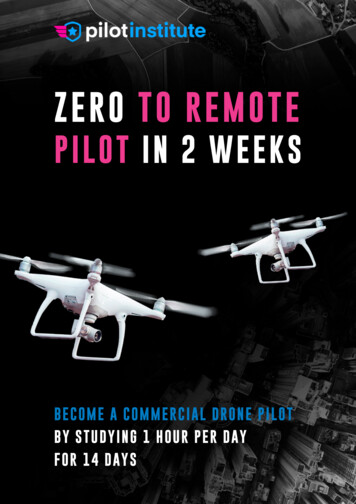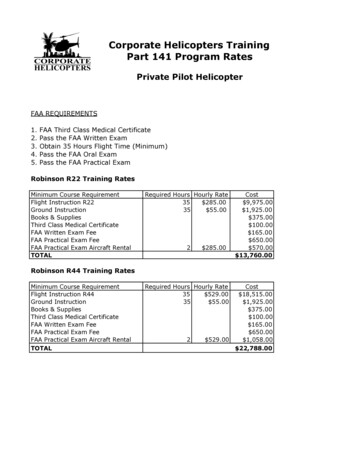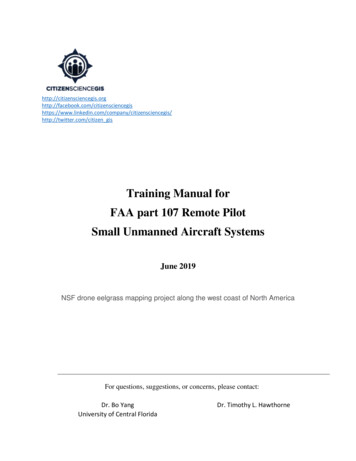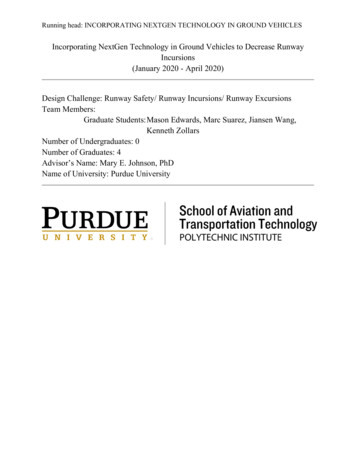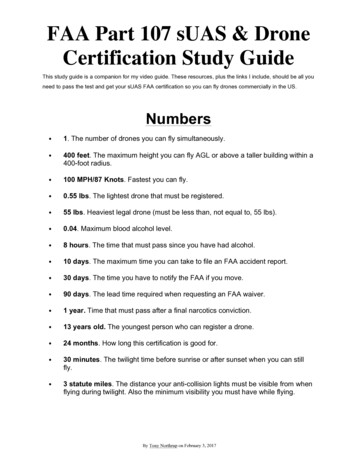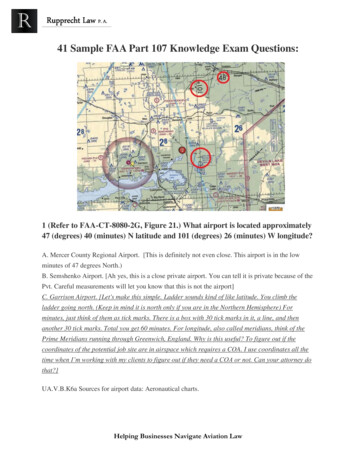
Transcription
41 Sample FAA Part 107 Knowledge Exam Questions:1 (Refer to FAA-CT-8080-2G, Figure 21.) What airport is located approximately47 (degrees) 40 (minutes) N latitude and 101 (degrees) 26 (minutes) W longitude?A. Mercer County Regional Airport. [This is definitely not even close. This airport is in the lowminutes of 47 degrees North.)B. Semshenko Airport. [Ah yes, this is a close private airport. You can tell it is private because of thePvt. Careful measurements will let you know that this is not the airport]C. Garrison Airport. [Let's make this simple. Ladder sounds kind of like latitude. You climb theladder going north. (Keep in mind it is north only if you are in the Northern Hemisphere) Forminutes, just think of them as tick marks. There is a box with 30 tick marks in it, a line, and thenanother 30 tick marks. Total you get 60 minutes. For longitude, also called meridians, think of thePrime Meridians running through Greenwich, England. Why is this useful? To figure out if thecoordinates of the potential job site are in airspace which requires a COA. I use coordinates all thetime when I’m working with my clients to figure out if they need a COA or not. Can your attorney dothat?]UA.V.B.K6a Sources for airport data: Aeronautical charts.Helping Businesses Navigate Aviation Law
2 (Refer to FAA-CT-8080-2G, Figure 26.) What does the line of latitude at area 4measure?A. The degrees of latitude east and west of the Prime Meridian. [This is partially true. It is correct tosay degrees of latitude but incorrect to say west. Latitude goes north & south like you are climbing alatter.]B. The degrees of latitude north and south from the equator. [Like you are climbing a later going upor down. Just remember which hemisphere you are in. 99% of you guys aren't going below theequator so it will be north most of the time.]C. The degrees of latitude east and west of the line that passes through Greenwich, England. [Justanswer A repackaged.]UA.V.B.K6a Sources for airport data: Aeronautical charts.Helping Businesses Navigate Aviation Law
3 (Refer to FAA-CT-8080-2G, Figure 23, area 3.) What is the floor of theSavannah Class C airspace at the shelf area (outer circle)?A. 1,300 feet AGL. [It is NEVER AGL. There is a lot that can be said here, but if you want to knowmore, study out barometers and the different types of altitude.]B. 1,300 feet MSL. [Remember the two zeros are chopped off. SFC means surface. Why is thisimportant? Because you might need to do a job under the Class C shelf. If you don't know this rightoff the top of your head, you are leaving money on the table. Remember that Class Coperations require a waiver (COA). You need to be able to say quickly, "Yes, we can do that job" or"No, we can't do that job and I'll have to file a COA to fly in Class C airspace." If you need helpfiling a COA in Class C, contact me.]C. 1,700 feet MSL.UA.II.A.K1b General airspace: Class C controlled airspace.Helping Businesses Navigate Aviation Law
4 (Refer to FAA-CT-8080-2G, Figure 59, area 2.) The chart shows a gray linewith "VR1667, VR1617, VR1638, and VR1668." Could this area present ahazard to the operations of a small UA?A. No, all operations will be above 400 feet.B. Yes, this is a Military Training Route from 1,500 feet AGL. [It is extremely important to know thisso you can expect low-flying military helicopters flying this route. Some of which may be at 400ft orbelow. Here is what the AIM says: "(a) MTRs with no segment above 1,500 feet AGL must beidentified by four number characters; e.g., IR1206, VR1207. (b) MTRs that include one or moresegments above 1,500 feet AGL must be identified by three number characters; e.g., IR206, VR207."What does this mean? They can ALWAYS be flying in your airspace.]C. Yes, the defined route provides traffic separation to manned aircraft.UA.II.A.K2 Special use within airspace. (Prohibited, restricted, warning, military operations, alert,and controlled firing.)Helping Businesses Navigate Aviation Law
5 According to 14 CFR part 107 the remote pilot in command (PIC) of a smallunmanned aircraft planning to operate within Class C airspaceA. must use a visual observer. [Nope. Only Part 107 FPV racers or 333 operators need a VO.]B. is required to file a flight plan. [You don't have to be on a flight plan to fly in Class C.]C. is required to receive ATC authorization. [Bingo. Why? Because the FAA ATC wants to make sureyou can fly in certain locations. Pro tip: Look at the runway of the Class C airport in Figure 23. Therunways are North, South, East, and West. If you are flying in the "doughnut hole," then you betterknow where the landing and departing traffic will be flying. Keep in mind that for some airports,especially at coastal airports, almost rarely use their northerly or southerly runways because thewind is almost always blowing east or west. You might be able to get a COA for those north or southareas of the airport easier. As always, if you need help getting one, contact me.]UA.II.A.K1b General airspace: Class C controlled airspace.Helping Businesses Navigate Aviation Law
6 (Refer to FAA-CT-8080-2G, Figure 21.) You have been hired by a farmer touse your small UA to inspect his crops. The area that you are to survey is in theDevil s Lake West MOA, east of area 2. How would you find out if the MOA isactive?A. Refer to the legend for special useairspace phone number. [Ok. Thisanswer is wrong. You won't be gettingany telephone numbers here. You'll getVHF frequencies on the side of the mapwhere the MOAs are listed. How doyou find the MOAs on the side? This isannoying because most of you guys areusing some type of digital map. This ishow you find it on Skyvector. You makesure the sectional chart at the top rightis clicked and then you move over all the way to the left and you'll see a list of all the MOAs. ThisHelping Businesses Navigate Aviation Law
MOA is from 0-4000 so we need to figure out if it is active. Some MOAs are higher and we wouldn'tneed to find out if they were active if they were higher. The 135.25 frequency won't help becauseyou'll almost never get ahold of anyone with your handheld. This is how to figure out if it is active ornot. You can either (1) Check to see if there is an activeNOTAM on https://www.notams.faa.gov/dinsQueryWeb/ which has its own MOA tab, (2) checkon https://pilotweb.nas.faa.gov/PilotWeb/ (3) check on DUATS, (4) call up 1-800-WX-BRIEF, or (5)call via phone the ARTCC over the area which would be Minneapolis Center. Here is the FAA webpage to find the ARTCC phone numbers. I personally would use DUATS because it records that yourequested the information which is handy if things go bad. You can't prove if you read it, but you canprove you at least requested it. See my article on 5 ways to prove you did a pre-flight briefing. If youare interested in setting up flight programs and want a more comprehensive set of guidelines thatincludes this information and more, contact me. I work with other highly skilled commercialpilots to develop flight operations and procedures manuals that are integrated with the exemptionsand waivers. Advertisement over.]B. This information is available in the Small UAS database. [What? I don't know what this means.There is no such thing.]C. In the Military Operations Directory. [No such thing.]UA.II.A.K2 Special use within airspace. (Prohibited, restricted, warning, military operations, alert,and controlled firing.)Helping Businesses Navigate Aviation Law
7 (Refer to FAA-CT-8080-2G, Figure 20, area 3.) How would a remote PIC"CHECK NOTAMS" as noted in the CAUTION box regarding the unmarkedballoon?A. By utilizing the B4UFLY mobile application. [That would be a nice feature but I don't know howmuch money the FAA will put into this app. That app is more like an airspace for dummies app.Airmap also dumbs things down and says you can't fly in a lot of places you can. Learn how to readcharts so you know where you can legally fly to make more money.]B. By contacting the FAA district office. [Nope. However, you should reach out to meet with theseguys sometime. Let them know you are trying to be compliant and professional. Better to "set thestage" with that than if they come after you and remember you as the guy who did .]C. By obtaining a briefing via an online source such as: 1800WXBrief.com. [You could do this. Isuggest reading my article on 5 Ways to Prove You Did a Pre-Flight Briefing.]UA.II.B.K5 The NOTAM system including how to obtain an established NOTAM through FlightService.Helping Businesses Navigate Aviation Law
8 To ensure that the unmanned aircraft center of gravity (CG) limits are notexceeded, follow the aircraft loading instructions specified in theA. Pilot's Operating Handbook or UAS Flight Manual. [I don't know of any drone manufacturerswho have created a manual which allows you to calculate the CG. Manned aviation manuals haveways you can calculate so you don't exceed CG limits. I think some of the reasons why the dronemanuals don't have them are because (1) the manufacturers are "toy" manufacturers who know littleabout aerodynamics, (2) they don't want to waste money on something that isn't required, and (3) thedrones they sell can't carry any payload so the CG is static.]B. Aeronautical Information Manual (AIM). [Great for general aviation info but bad for specificaircraft info.]C. Aircraft Weight and Balance Handbook. [This looks like a great answer but it isn't. Thishandbook is helpful for studying for the test but won't tell you anything about your specific aircraft.]UA.IV.A.K1b General loading and performance: Balance, stability, and center of gravity.9 When operating an unmanned airplane, the remote pilot should consider thatthe load factor on the wings may be increased anytimeA. the CG is shifted rearward to the aft CG limit. [This wouldn't increase load factor. If the airplaneuses an elevator for pitch, this would actually DECREASE load factor.]B. the airplane is subjected to maneuvers other than straight and level flight. [Here is a helpful videoexplaining this. Here is another helpful link. See next question for more discussion.]C. the gross weight is reduced. [Gross weight reduction would DECREASE load factor.]UA.IV.A.K2. The importance and use of performance data to predict the effect on the aircraft’sperformance of an sUAS.Helping Businesses Navigate Aviation Law
10 A stall occurs when the smooth airflow over the unmanned airplane s wing isdisrupted, and the lift degenerates rapidly. This is caused when the wingA. exceeds the maximum speed. [You won't stall at this speed. Your wings will pop off becauseof drag.]B. exceeds maximum allowable operating weight. [This isn’t true. You can fly somewhat overweightall day long (not legally), but it isn't going to cause your wings to stall or pop off. We care aboutflying overweight in turbulent air or when doing abrupt maneuvers that can over stress the aircraftand break it. This is why we have maneuvering speed in manned aircraft so we know what speed tokeep our aircraft below so we don't break it in the event of a full control deflection because theaircraft will stall before it exceeds its category limits for what the aircraft was certificated for. Thereare no aircraft category G limits like manned aircraft. All Part 107 aircraft are not required to have anairworthiness certificate like manned aircraft. So flying a drone “overweight” isn’t the same as flyinga certificated manned aircraft over the weight which might exceed category limits in a full controldeflection.]C. exceeds its critical angle of attack. [You aren’t going to be flying if you hit this angle no matterhow fast you are going. Here is a great example of a Sukhoi Su-35 Russian jet doing theCobra maneuver which exceeds its critical angle of attack. ]UA.IV.A.K1b General loading and performance: Balance, stability, and center of gravity.Helping Businesses Navigate Aviation Law
11 (Refer to FAA-CT-8080-2G, Figure 2.) If an unmanned airplane weighs 33pounds, what approximate weight would the airplane structure be required tosupport during a 30 banked turn while maintaining altitude?[Explanation: In a turn of 30 degrees of bank and while maintaining level flight (no altitude lossbecause you slightly pitched up), you will have a 1.154 load factor. This means that in this turn youwill be feeling like you are pulling 1.154 G’s. 33 pounds x 1.154 38.082 pounds].A. 34 pounds.B. 47 pounds.C. 38 pounds.UA.IV.A.K2. The importance and use of performance data to predict the effect on the aircraft’s2.performance of an sUAS.Helping Businesses Navigate Aviation Law
12 Which is true regarding the presence of alcohol within the human body?A. A small amount of alcohol increases vision acuity. [No, you may think that but it isn’t true.]B. Consuming an equal amount of water will increase the destruction of alcohol and alleviate ahangover. [No, it just means you are going to be a drunk who has to go to the bathroom.]C. Judgment and decision-making abilities can be adversely affected by even small amounts ofalcohol. [Yes, being drunk can result in all sorts of poor life choices such as getting involved inPokemon.]UA.V.E.K2 Drugs and alcohol use.13 When using a small UA in a commercial operation, who is responsible forbriefing the participants about emergency procedures?A. The FAA inspector-in-charge. [Um. No. The FAA inspector is the person who investigates yourgoof up.]B. The lead visual observer. [Nope. But this person is great for doing the “coffee & doughnuts”briefing.]C. The remote PIC. [Bingo! Being the pilot in command means you are responsible. Period. Foreverything. For example, if you don’t properly brief your VO and a FAA inspector ramp checks andthe VO doesn’t know what is going on, you get in trouble. It’s like being at the bottom of a gutter, allthe garbage will flow your way.]UA.V.C.K1 Emergency planning and communication.Helping Businesses Navigate Aviation Law
14 To avoid a possible collision with a manned airplane, you estimate that yoursmall UA climbed to an altitude greater than 600 feet AGL. To whom must youreport the deviation?A. Air Traffic Control. [If you are flying without an airspace waiver, 600ft isn’t even in controlledairspace so you wouldn’t be contacting ATC. It might be wise to just quickly mention on the CTAFwhere you are if you were flying near a Class G airport and you had to do an emergency deviation upto 600ft.]B. The National Transportation Safety Board. [See What Do I Do After a Drone Crash?]C. Upon request of the Federal Aviation Administration. [See What Do I Do After a Drone Crash?]UA.V.C.K1 Emergency planning and communication.Helping Businesses Navigate Aviation Law
15 (Refer to FAA-CT-8080-2G, Figure 26, area 2.) While monitoring theCooperstown CTAF you hear an aircraft announce that they are midfield leftdownwind to RWY 13. Where would the aircraft be relative to the runway?A. The aircraft is East. [Runway 13 has a magnetic heading of 130. Keep in mind that our VFRsectionals are in true, not magnetic, but VORs and runway headings are magnetic. You know whichway the airplane took off by looking at the runway orientation. The runways on the map tend to bepretty close to what they are in real life. The airport pattern in the U.S. goes to the left (because thecaptain or pilot tends to fly on that side and has a better view of the runway and it is the law). Theexceptions to this are if ATC at a tower, visual markings or lights, AFD, or the sectional with an RPsymbol next to the airport say otherwise. There is no RP on Cooperstown so it is left. So if airplanesare going left, you should fly on the right hand pattern side right? WRONG! Helicopters are requiredby law to avoid the flow of fixed-wing aircraft and tend to be lower.]B. The aircraft is South.C. The aircraft is West.UA.V.A.K3 Recommended traffic advisory procedures. (such as: self-announcing of position andintentions by manned aviation operations and activities.)Helping Businesses Navigate Aviation Law
16 Under what condition should the operator of a small UA establish scheduledmaintenance protocol?A. When the manufacturer does not provide a maintenance schedule. [Yes, because you should knowwhat the mean time between failures is or have an idea on what are the typical problems certaindrones encounter so you can PREVENT crashes. It is also good for your bottom line to have aircraftthat work when you want to go fly them rather than having crews drive back and forth to the office topick up more aircraft.]B. UAS does not need a required maintenance schedule. [I can hear it now from some of the droners“Maintenance .We don’t need no stinkin maintenance.”]C. When the FAA requires you to, following an accident. [It is cheaper to do maintenance on thefront end rather than on the pieces on the backend.]UA.V.F.K1 Basic maintenance.17 According to 14 CFR part 107, the responsibility to inspect the small UAS toensure it is in a safe operating condition rests with theA. remote pilot-in-command. [107.19 says, “(b) The remote pilot in command is directly responsiblefor and is the final authority as to the operation of the small unmanned aircraft system. (c) Theremote pilot in command must ensure that the small unmanned aircraft will pose no undue hazard toother people, other aircraft, or other property in the event of a loss of control of the aircraft for anyreason” How are you going to do that without doing an inspection on the aircraft and being familiarwith it? § 107.49 says, “(c) Ensure that all control links between ground control station and thesmall unmanned aircraft are working properly; (d) If the small unmanned aircraft is powered, ensurethat there is enough available power for the small unmanned aircraft system to operate for theintended operational time; and (e) Ensure that any object attached or carried by the small unmannedaircraft is secure and does not adversely affect the flight characteristics or controllability of theaircraft.” ]B. visual observer. [No responsibility here but it would be smart to have the VO checking thingsalso.]C. owner of the small UAS. [Smart but not required.]UA.V.F.K2 Preflight inspection.Helping Businesses Navigate Aviation Law
18 Identify the hazardous attitude or characteristic a remote pilot displays whiletaking risks in order to impress others?A. Impulsivity. [This is doing something quickly without thinking it out.]B. Invulnerability. [This is doing something dumb but you think an accident won’t happen to you.Please see the many dumb people on Youtube flying their aircraft over streets in urban areas.]C. Macho. [You act macho to impress others.]UA.V.D.K4 Hazardous attitudes19 You are a remote pilot for a co-op energy service provider. You are to useyour UA to inspect power lines in a remote area 15 hours away from your homeoffice. After the drive, fatigue impacts your abilities to complete your assignmenton time. Fatigue can be recognizedA. easily by an experienced pilot. [An experienced pilot should recognize that fatigue can creep upon them and they shouldn’t trust themselves.]B. as being in an impaired state. [You should give your body proper rest so as to function optimally.Commercial pilots have rest requirements for a reason. You should also.]C. by an ability to overcome sleep deprivation. [This isn’t fatigue. This is Redbull.]UA.V.E.K5 Stress and fatigue.Helping Businesses Navigate Aviation Law
20 Safety is an important element for a remote pilot to consider prior tooperating an unmanned aircraft system. To prevent the final "link" in theaccident chain, a remote pilot must consider which methodology?A. Crew Resource Management. [“Crew resource management (CRM). The application of teammanagement concepts in the flight deck environment. It was initially known as cockpit resourcemanagement, but as CRM programs evolved to include cabin crews, maintenance personnel, andothers, the phrase “crew resource management” was adopted. This includes single pilots, as in mostgeneral aviation aircraft. Pilots of small aircraft, as well as crews of larger aircraft, must makeeffective use of all available resources; human resources, hardware, and information. A currentdefinition includes all groups routinely working with the flight crew who are involved in decisionsrequired to operate a flight safely. These groups include, but are not limited to pilots, dispatchers,cabin crewmembers, maintenance personnel, and air traffic controllers. CRM is one way ofaddressing the challenge of optimizing the human/machine interface and accompanying interpersonalactivities.”]B. Safety Management System. [“SMS is the formal, top-down, organization-wide approach tomanaging safety risk and assuring the effectiveness of safety risk controls. It includes systematicprocedures, practices, and policies for the management of safety risk.”]C. Risk Management. [This is the part of the decision making process which relies on situationalawareness, problem recognition, and good judgment to reduce risks associated with each flight.]UA.V.D.K1 Aeronautical Decision Making (ADM).Helping Businesses Navigate Aviation Law
21 When adapting crew resource management (CRM) concepts to the operationof a small UA, CRM must be integrated intoA. the flight portion only. [This is wrong because the pre-flight portion and post flight portion needattention also for safety. Who checked on TFRs, weather, etc? Who charged the batteries? Who isgoing to charge the batteries and log the before and after voltages?]B. all phases of the operation. [“All groups routinely working with the flight crew who are involvedin decisions required to operate a flight safely. These groups include, but are not limited to pilots,dispatchers, cabin crewmembers, maintenance personnel, and air traffic controllers.”]C. the communications only. [Nope. Into everything when people are involved.]UA.V.D.K2 Crew Resource Management (CRM).22 You have been hired as a remote pilot by a local TV news station to filmbreaking news with a small UA. You expressed a safety concern and the stationmanager has instructed you to “fly first, ask questions later.” What type ofhazardous attitude does this attitude represent?A. Machismo. [It isn’t this one because you aren’t trying to prove yourself to be awesome.]B. Invulnerability. [Close. But it isn’t right. Invulnerability recognizes that the accident CAN happen,“but not to me.” Here there is NO recognition of the possibility of an accident being possible.]C. Impulsivity. [From PHAK, “This is the attitude of people who frequently feel the need to dosomething, anything, immediately. They do not stop to think about what they are about to do, they donot select the best alternative, and they do the first thing that comes to mind.”]UA.V.D.K4 Hazardous attitudes.Helping Businesses Navigate Aviation Law
23 A local TV station has hired a remote pilot to operate their small UA to coverbreaking news stories. The remote pilot has had multiple near misses withobstacles on the ground and two small UAS accidents. What would be a solutionfor the news station to improve their operating safety culture?A. The news station should implement a policy of no more than five crashes/incidents within 6months. [But why 5? 5 crashes a year? A month? This is just a standard with no data behind it.]B. The news station does not need to make any changes; there are times that an accident isunavoidable. [There is not enough information to know they do not need to make any changes.Maybe they have identified all the risks and attempted to mitigate them. Generally, you could andshould be trying to do something to increase safety.]C. The news station should recognize hazardous attitudes and situations and develop standardoperating procedures that emphasize safety. [The hazardous attitudes would be an easy fix with thecrew to help identify any hazards in the group. The SOP helps prevent pilots from forgetting things.SOPs are great at managing risk. What gets measured gets managed. There needs to be datagathered after the flights to find out how to best optimize the SOPs. Over time, the SOPs will beimproved by identifying risks, implementing mitigations in the SOPs to counter those risks, andmeasuring the effectiveness of those mitigations. SOPs aren’t stagnant.]UA.V.D.K1 Aeronautical Decision Making (ADM).Helping Businesses Navigate Aviation Law
24 (Refer to FAA-CT-8080-2G, Figure 22, area 2.) At Coeur D Alene whichfrequency should be used as a Common Traffic Advisory Frequency (CTAF) tomonitor airport traffic?A. 122.05 MHz. [This is the frequency to contact Boise Flight Service on.]B. 135.075 MHz. [This is the AWOS, not the CTAF. You can check out the airport weather on thisfrequency. Would also be great to find out what the surface winds are blowing at that location.].C. 122.8 MHz. [This is the CTAF].UA.V.B.K6a Sources for airport data: Aeronautical charts.Helping Businesses Navigate Aviation Law
25 (Refer to FAA-CT-8080-2G, Figure 26, area 4.) You have been hired toinspect the tower under construction at 46.9N and 98.6W, near JamestownRegional (JMS). What must you receive prior to flying your unmanned aircraftin this area?A. Authorization from the military. [This isn’t military airspace.]B. Authorization from ATC. [I believe what the test writer was trying to convey was that this tower isjust on the inside of Class E at the surface. This WOULD require an airspace waiver. If it on the justoutskirt of class E at the surface, then you wouldn’t need a waiver. The magenta halo means Class Estarts at 700ft while the dashed magenta line means Class E starts at the surface. That blue compassis a VOR used for navigation that is located on the north end of the field. See that little white dot inthe circle? That is the VOR located on the field.]C. Authorization from the National Park Service. [There is no national park here.]UA.V.B.K6a Sources for airport data: Aeronautical charts.Helping Businesses Navigate Aviation Law
26 (Refer to FAA-CT-8080-2G, Figure 20, area 3.) With ATC authorization, youare operating your small unmanned aircraft approximately 4 SM southeast ofElizabeth City Regional Airport (ECG). What hazard is indicated to be in thatarea?A. High density military operations in the vicinity.B. Unmarked balloon on a cable up to 3,008 feet AGL. [It says MSL right on the sectional. Even if itdidn’t, it would have to be MSL because pilots flying don’t have an accurate way of determiningAGL and are using their aneroid barometers which is trying to put out an indicated altitude ballparkish to MSL.]C. Unmarked balloon on a cable up to 3,008 feet MSL. [Keep in mind that if you are flying 4SM fromthe airport, you are within 4 nautical miles from the airport. Class D airports generally have aradius of 4NM. You would need an airspace waiver to operate in this area. Contact me if you needone! ]UA.V.B.K6a Sources for airport data: Aeronautical charts.Helping Businesses Navigate Aviation Law
27 The most comprehensive information on a given airport is provided byA. the Chart Supplements U.S. (formerly Airport Facility Directory). [This will tell you all sorts ofthings. Ever wonder how you get the phone number of the airport manager to make phone calls ifyou are flying recreationally within 5nm of an airport? This is how!]B. Notices to Airmen (NOTAMS). [Um no. These will tell you SOME things about the airport.]C. Terminal Area Chart (TAC). [This map is a 2x zoomed in version of the sectional.]UA.V.B.K6b Sources for airport data: Chart Supplements U.S. (formerly Airport/facility directory)28 According to 14 CFR part 107, who is responsible for determining theperformance of a small unmanned aircraft?A. Remote pilot-in-command. [See 107.19. Learn the short version of this regulation. “If anythinggoes wrong, it is most likely the PIC’s fault.” You shouldn’t let anyone force you into flyingsomewhere or doing something you feel is unsafe. You are getting the whacking if anything goeswrong, not them.].B. Manufacturer.C. Owner or operator.UA.I.B.K20 Preflight familiarization, inspection, and actions for aircraft operations.29 Which technique should a remote pilot use to scan for traffic? A remote pilotshouldA. systematically focus on different segments of the sky for short intervals. [From the AIM 8 1 6.(c), “Because the eyes can focus only on this narrow viewing area, effective scanning isaccomplished with a series of short, regularly spaced eye movements that bring successive areas ofthe sky into the central visual field. Each movement should not exceed 10 degrees, and each areashould be observed for at least 1 second to enable detection. Although horizontal back-and-forth eyemovements seem preferred by most pilots, each pilot should develop a scanning pattern that is mostcomfortable and then adhere to it to assure optimum scanning.]B. concentrate on relative movement detected in the peripheral vision area. [Bad idea. From AC 9048D 4.2.5, “It is essential to remember, however, that if another aircraft appears to have no relativemotion, it is likely to be on a collision course with you. If the other aircraft shows no lateral orvertical motion, but is increasing in size, take immediate evasive action.”]Helping Businesses Navigate Aviation Law
C. continuously scan the sky from right to left. [What about up and down also!? Additionally, youneed some time to focus on a particular segment of sky.]I’m guessing the correct one should be UA.V.E.K6 Factors affecting vision.Helping Businesses Navigate Aviation Law
30 Under what condition would a small UA not have to be registered before it isoperated in the United States?A. When the aircraft weighs less than .55 pounds on takeoff, including everything that is on-board orattached to the aircraft. [What can be helpful to determine .55 pounds is approximately two sticks ofbutter. No seriously. The FAA said two sticks of butter. I’m not making this up. I can see next time Iam
41 Sample FAA Part 107 Knowledge Exam Questions: 1 (Refer to FAA-CT-8080-2G, Figure 21.) What airport is located approximately 47 (degrees) 40 (minutes) N latitude and 101 (degrees) 26 (minutes) W longitude? A. Mercer County Regional Airport. [This is definitely not even close. This airport is in the low minutes of 47 degrees North.)
